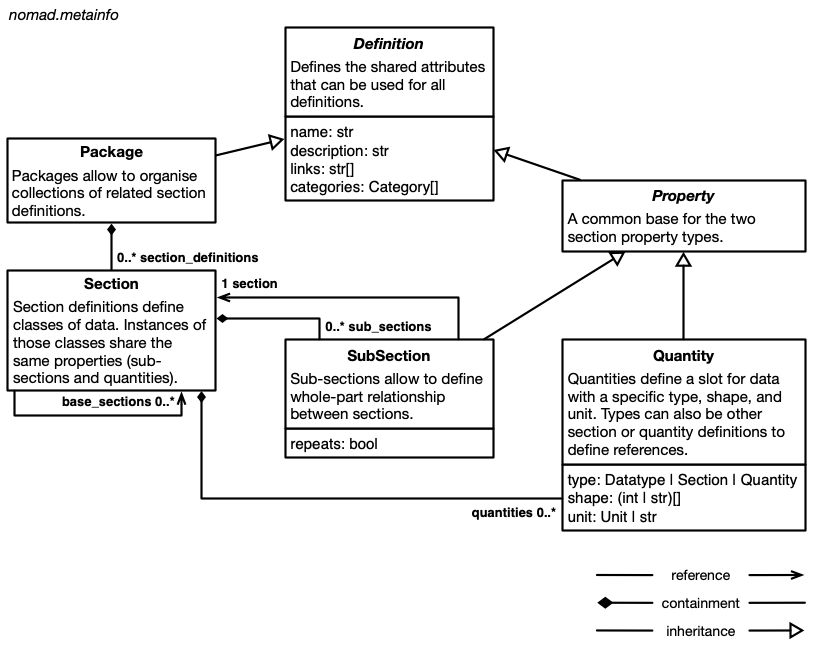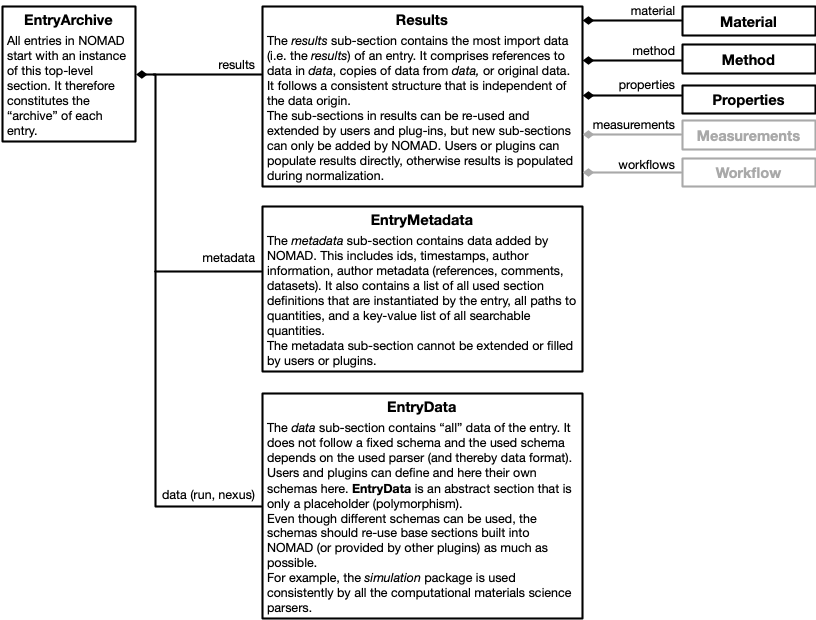Data structure
NOMAD structures data into sections, where each section can contain data and more sections. This allows to browse complex data like you would browse files and directories on your computer. Each section follows a definition and all the contained data and subsection have a specific name, description, possible type, shape, and unit. This means that all data follows a schema. This not only helps the human exploration, but also makes it machine interpretable, increases consistency and interoperability, enables search, APIs, visualization, and analysis.
Schema language¶
The bases for structured data are schemas written in a schema language. Our schema language is called the NOMAD Metainfo language. The name is evocative of the rich metadata information that should be associated with the research data and made available in a machine-readable format. It defines the tools to define sections, organize definitions into packages, and define section properties (subsections and quantities).
Packages contain section definitions, section definitions contain definitions for subsections and quantities. Sections can inherit the properties of other sections. While subsections allow to define containment hierarchies for sections, quantities can use section definitions (or other quantity definitions) as a type to define references.
If you are familiar with other schema languages and means to defined structured data (json schema, XML schema, pydantic, database schemas, ORM, etc.), you might recognize these concept under different names. Sections are similar to classes, concepts, entities, or tables. Quantities are related to properties, attributes, slots, columns. subsections might be called containment or composition. subsections and quantities with a section type also define relationships, links, or references.
Our guide on how to write a schema explains these concepts with an example.
Schema¶
NOMAD represents many different types of data. Therefore, we cannot speak of just the one schema. The entirety of NOMAD schemas is called the NOMAD Metainfo. Definitions used in the NOMAD Metainfo fall into three different categories. First, we have sections that define a shared entry structure. Those are independent of the type of data (and processed file type). They allow to find all generic parts without any deeper understanding of the specific data. Second, we have definitions of re-usable base sections for shared common concepts and their properties. Specific schemas can use and extend these base sections. Base sections define a fixed interface or contract that can be used to build tools (e.g. search, visualizations, analysis) around them. Lastly, there are specific schemas. Those re-use base sections and complement the shared entry structure. They define specific data structures to represent specific types of data.
Base sections¶
Base section is a very loose category. In principle, every section definition can be
inherited from or can be re-used in different contexts. There are some dedicated (or even abstract)
base section definitions (mostly defined in the nomad.datamodel.metainfo package and sub-packages),
but schema authors should not strictly limit themselves to these definitions.
The goal is to re-use as much as possible and to not re-invent the same sections over
and over again. Tools build around certain base section, provide an incentive to
use them.
Attention
There is no detailed how-to or reference documentation on the existing base sections and how to use them yet.
One example for re-usable base section is the workflow package. These allow to define workflows in a common way. They allow to place workflows in the shared entry structure, and the UI provides a card with workflow visualization and navigation for all entries that have a workflow inside.
Attention
Currently there are two version of the workflow schema. They are stored in two
top-level EntryArchive subsections (workflow and workflow2). This
will change soon to something that supports multiple workflows used in
specific schemas and results.
Specific schemas¶
Specific schemas allow users and plugin developers to describe their data in all detail. However, users (and machines) not familiar with the specifics, will struggle to interpret these kinda of data. Therefore, it is important to also translate (at least some of) the data into a more generic and standardized form.
The results section provides a shared structure designed around base section definitions. This allows you to put (at least some of) your data where it is easy to find, and in a form that is easy to interpret. Your non-interoperable, but highly detailed data needs to be transformed into an interoperable (but potentially limited) form.
Typically, a parser will be responsible to populate the specific schema, and the interoperable schema parts (e.g. section results) are populated during normalization. This allows to separate certain aspects of conversions and potentially enables re-use for normalization routines. The necessary effort for normalization depends on how much the specific schema deviates from base-sections. There are three levels:
- the parser (or uploaded archive file) populates section results directly
- the specific schema re-uses the base sections used for the results and normalization can be automated
- the specific schema represents the same information differently and a translating normalization algorithm needs to be implemented.
Exploring the schema¶
All built-in definitions that come with NOMAD or one of the installed plugins can
be explored with the Metainfo browser. You can start with the root section EntryArchive
and browse based on subsections, or explore the Metainfo through packages.
To see all user provided uploaded schemas, you can use a search for the subsection definition.
The subsection definition is a top-level EntryArchive subsection. See also our
how-to on writing and uploading schemas.
Contributing to the Metainfo¶
The shared entry structure (including section results) is part of the NOMAD source-code. It interacts with core functionality and needs to be highly controlled. Contributions here are only possible through merge requests.
Base sections can be contributed via plugins. Here they can be explored in the Metainfo browser, your plugin can provide more tools, and you can make use of normalize functions. See also our how-to on writing schema packages. You could also provide base sections via uploaded schemas, but those are harder to explore and distribute to other NOMAD installations.
Specific schemas can be provided via plugins or as uploaded schemas. When you upload schemas, you most likely also upload data in archive files (or use ELNs to edit such files). Here you can also provide schemas and data in the same file. In many case specific schemas will be small and only re-combine existing base sections. See also our how-to on writing YAML schemas.
Data¶
All processed data in NOMAD instantiates Metainfo schema definitions and the archive of
each entry is always an instance of EntryArchive. This provides an abstract structure
for all data. However, it is independent of the actual representation of data in computer memory
or how it might be stored in a file or database.
The Metainfo has many serialized forms. You can write .archive.json or .archive.yaml
files yourself. NOMAD internally stores all processed data in message pack. Some
of the data is stored in mongodb or elasticsearch. When you request processed data via
API, you receive it in JSON. When you use the ArchiveQuery, all data is represented
as Python objects (see also example in schema package documentation).
No matter what the representation is, you can rely on the structure, names, types, shapes, and units defined in the schema to interpret the data.
Archive files: a shared entry structure¶
Broadening the discussion on the entry files that one can find in NOMAD, both schemas or processed data are serialized as the same kind of archive file, either .archive.json or .archive.yaml.
The NOMAD archive file is indeed composed by several sections.
NOMAD archive file:EntryArchive
- definitions:
Definitions - metadata:
EntryMetadata - data:
EntryData - run:
Run - nexus:
Nexus - workflow:
LegacyWorkflow - workflow2:
Workflow - results:
Results
They all instantiate the same root section EntryArchive. They all share common sections metadata:Metadata
and results:Results. They also all contain a data section, but the used section
definition varies depending on the type of data of the specific entry. There is the
literal data:EntryData subsection. Here EntryData is abstract and specific entries
will use concrete definitions that inherit from EntryData. There are also specific data
sections, like run for simulation data and nexus for nexus data.
Note
As shown in Uploading schemas, one can, in principle, create an archive file with both definitions and one of the data sections filled, although this is not always desired because it will stick together a schema and a particular instance of that schema. They should be kept separate so that it is still possible to generate new data files from the same schema file.
Attention
The results, originally only designed for computational data, will soon be revised an replaced by a different section. However, the necessity and function of a section like this remains.




